By Maggie Shui
When we talk about race relations in this country, how often do we consider the relations between Asian tauiwi and tangata whenua? It’s time for all of us Asian New Zealanders to come to terms with our status as settlers on colonised land, and find solidarity with the Indigenous people of the place we’ve chosen to move to.
“When you and your parents came to New Zealand, were you aware of Māori at all?”
This is the question Manying Ip, an academic who has researched and written extensively on Māori-Chinese relations throughout history, poses to me. Embarrassingly, I hadn’t ever thought to ask my parents this.
We moved to Aotearoa from Luoyang, a city in China’s Henan province, in the 90s; I was five months old and my parents were “skilled migrants”. It’s a classic story for many of our recent pan-Asian migrants in this country, for whom moving here became a lot easier once New Zealand’s immigration criteria began to focus more on skills and money rather than countries of origin. When I tell Manying my parents were both engineers, she laughs at how stereotypical it all is. “Ah, engineers! Remember, it was a point system and engineering already carried 15. You only need 20.”
To answer Manying’s question, it’s safe to say that in 1995 my family was moving into what we saw as a Pākehā world. For centuries, tangata whenua had lived, educated, healed, disputed and settled according to Māori systems and beliefs. In the last 250 years, colonisers to this country and their descendents replaced many of those existing structures with European ones. And they built those structures on land taken by conquest, confiscation and exploitative purchase.
Those replacements are now our default. On the mainstream level, we now live, educate, heal, dispute and settle within systems that, at their core, stem from white European origins. So when we talk about race relations in this country, we tend to focus on relations between Māori and Pākehā.
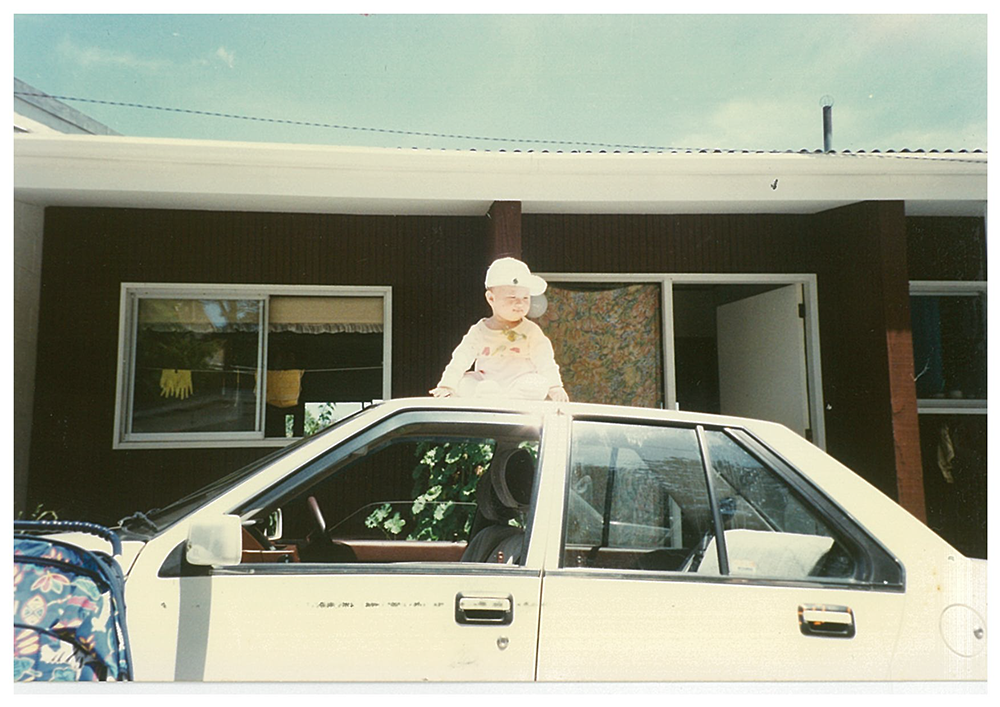
The writer as a baby Chinese immigrant in Aotearoa, 1996.
But where do Asian New Zealanders fit in this, if we have a place in this at all? The classic reason our parents give for moving to New Zealand is “for a better life”. So some people might argue we should just leave it to Māori and Pākehā to duke it out via Treaty settlements and opinion articles, while we quietly focus on building those better lives and doing justice to the sacrifices our parents made in moving here. Besides, they argue, our ancestors were not the ones who took Indigenous land by conquest, confiscation and exploitative purchase. In the grand scheme of the history of Aotearoa, we just got here.
But really, that kind of thinking doesn’t cut it anymore. It’s time we examine our own relations to the Indigenous people of the land that we live on - of whom we may or may not have been aware of when we first came here. Once we start examining those relations, we can begin to grapple with our position as settlers on colonised land, and make greater sense of our place in this country. And from there, we might realise we have lots of reasons to stand in solidarity with tangata whenua.
What racism among Asian New Zealanders looks like
I can’t exalt Asian solidarity with tangata whenua without first confronting the racial prejudices that exist in our communities towards Māori people.
Henry, who doesn’t want to use his real name to keep his family anonymous, moved to New Zealand from China in the 90s. Like me, his parents were both engineers (another classic migrant story). The Tiananmen Square Massacre of 1989 was the final push in their decision to, in Henry’s words, “get the fuck out of China.” Once in Auckland, his dad’s first job was as a cleaner at Westfield Manukau. Now, Henry is 25 and works at a law firm and his family are what he’d call “upper middle class”.
He says his parents’ explicitly racist views are something he struggles to grapple with. “They’re real stereotypical views like Māori are all criminals, they don’t work hard, they just go on the benefit and get money for free,” says Henry. “And growing up as a kid, I was influenced by those views and that has shaped my understandings.”
It’s hard to explain to your parents who’ve worked and struggled more than you ever have that they are privileged in ways that other groups of New Zealanders are not. “They're thinking they immigrated here with nothing. They had no connections,” says Henry, trying to see it from his parents’ perspective. “And now, they’re in a decent position economically. They’re thinking, ‘We could do it so why can't brown people too?’”
This model minority mindset is prevalent among pan-Asian communities in Aotearoa. I’m sure these quotes are familiar to many of us.
But if Bill the Pākehā boomer tearing up the comments section has become the poster child of New Zealand racism at large, Asian parents espousing “pull yourself up by the bootstraps” philosophy has become the poster child of Asian New Zealand racism. Our anti-racism conversations tend to centre on matters like: How do we talk to our parents? How can we get them to understand systemic racism when we’re so bad at explaining things in our mother tongue? One law student I spoke to says she told her Fijian-Indian dad, “I feel bad on behalf of you,” as she struggled to get through to him why Bastion Point is rightfully Ngāti Whātua land. I admire her efforts to communicate what she learned from her corporate governance course to her dad - conversations like that take mental and emotional energy. However, her words sit uneasy for their mild paternalism.
Racism among Asian New Zealanders is not exclusive to our parents’ generation. Vivien Whyte grew up living in Epsom, a wealthy suburb in Auckland, with her Afakasi Samoan dad and Chinese Indonesian mum. She could see Asians at her school buying into a kind of model minority mindset, “perpetuated by the fact that we're all living in very privileged circumstances… When they see themselves as hard working, it's the same sort of mindset that their white peers have. They just see themselves in the same bubble as their white peers.”
This is especially true for East Asians such as Chinese and Korean New Zealanders. Alyssa Medel, a Filipino-Kiwi theatre maker, went to the same school as Vivien in Epsom. She says she and her family were lucky to stumble upon a rental that was “super affordable for where it was.”
High school for Alyssa was an isolating experience. Most of the Asians at her school came from privileged backgrounds and were either Chinese or Korean. The school’s most prominent Asian cultural clubs were geared to Chinese and Korean students. “It felt strange being the only brown person there and trying to be part of that group.” Like Vivien, she could see students buying into those similar pull-yourself-up-by-the-bootstraps philosophies that we associate with our parents’ generation - often in the form of resentment towards affirmative action initiatives like targeted admission schemes for Māori and Pacific students studying medicine.
Our parents benefit from New Zealand’s systems in ways that Māori and Pacific people do not. But many of us 1.5, 2nd and so forth generation Asian New Zealanders benefit from those systems so much more. We have the cultural capital of being fluent in English, which lets us navigate public spaces at ease, access more educational resources, enjoy tacit validation from white New Zealand and be less of a target of racial prejudice towards ourselves. Our parents might have built a comfortable wealth over the past few decades, which gives us the financial security to take more risks and live without a scarcity mentality. Henry’s parents protested in 1989 against an unchecked government that silenced demonstrators with deadly force - how much can someone like me teach them about structural oppression? They’ve lived through it, while I barely understood Foucault in a Stage II politics paper.
Alyssa says those mindsets that lead us to disparage measures such as university targeted admission schemes for Māori and Pacific students often stem from a lack of knowledge. “A lot of Asians in our generation are not aware of the historical context of it.” Those of us with English ability and access to educational resources, with the most political and economic power in our Asian communities, are best placed to rectify that lack of knowledge.
“We could do it so why can't brown people too?”
My dad learned about immigration to New Zealand through a newspaper ad while working in Nanjing. It’s more likely the ad featured Windows XP desktop-esque rolling hills and blue skies than any depiction of the Indigenous people who come from that land.
So once Chinese people from our recent immigration wave arrived in New Zealand, they, in Manying’s words, “took on the prejudice of the Pākehā world. Because they think that the Pākehā world is the norm. Because New Zealand is white, New Zealand is a Western country.” Many of these Chinese migrants go on to have little social interaction with tangata whenua, says Manying, mostly learning about Māori people through Chinese newspapers. And these newspapers tend to be filtered through a Pākehā lens as they’re often translations of mainstream English-language media (which don’t tend to have the most diverse newsrooms).
It becomes easy for the whiteness of the structures we live and work within to become invisible, while the token nods towards kaupapa Māori across our institutions become examples of how well we treat our Indigenous people in this country.

Our government follows the Westminster model, a system for government brought to Aotearoa by British colonisers. (Photo: Getty)
These institutions might be dressed in Māori names, such as Oranga Tamariki, or they might include entities such as the proposed Māori Health Authority in the government’s recently announced overhaul of our health system. But they are not institutions where Māori have rangatiratanga and mana motuhake - self-determination and autonomy - over themselves, and they are not institutions rooted in Māori values, tikanga Māori and te reo Māori.
For example, Oranga Tamariki, formerly called Child, Youth and Family (CYF), oversees a system where, as of June 2018, Māori children accounted for 68% of all children in state care. Can a system where Māori are so starkly overrepresented in child uplifts (Māori make up 16% of the population) possibly follow kaupapa Māori and recognise how intrinsic a connection to whānau and tūrangawaewae are to wellbeing? The Māori Health Authority, the proposed agency in the recent Health and Disability System Review, would focus on fixing the health disparities between Māori and non-Māori (on average, Māori live 7 years less than non-Māori and non-Pacific people). However, there’s no consensus on whether this entity would control the funding and commissioning of services for Māori. Is it really a Māori Health ‘Authority’ if the agency does not have authority over resources and funds? These are systems built from white European origins, with kaupapa Māori sprinkled on top in recent years insofar as they don’t mean self-determination for Māori.
The question, “We could do it so why can't brown people too?” presumes that Asian New Zealanders come from the same circumstances as Māori. Asian migrants are a broad and nebulous group of people who’ve all experienced racial prejudice and navigated racist structures in different ways. Some came to Aotearoa because the alternative was to live under an authoritarian government or in a postcolonial country struggling to find its feet after recently gaining independence from British rule.
But just as our tīpuna were not the ones who took Indigenous land by conquest, confiscation and exploitative purchase, our tīpuna were also not the ones who were dispossessed of that land, marking the beginning of intergenerational trauma that flows into today.
As Dr Moana Jackson writes, “If the years since 9/11 have been marked by a “war on terror”, they are merely a minuscule and perverse reflection of the fact that colonisation has, for centuries, been a violent and unrelenting global war of terror.”
Where do Asian New Zealanders fit in all this?
Manying recalls a Taiwanese woman she interviewed in her research. The woman arrived in New Zealand in the 90s thinking she was a welcome guest - she and fellow Asian migrants obtained visas through their education, work experience or money, after all. But soon after arriving, she began to feel like a “gate-crasher”.
Manying recalls, “She said it was like arriving at a party and your host and hostess are quarelling. The hostess says, ‘You should not have invited this person. You have not asked me. You have no right to let these people in.’ Because the immigration policy was not made by Māori. It was made by the mostly Pākehā government, where the Māori didn’t have a lot of say.”
Against a backdrop where reparations in the form of Treaty settlements had only just begun, te reo Māori had just been declared an official language of New Zealand and the country was beginning to grapple with what ‘biculturalism’, the buzzword of the time, means in practice, we saw another new influx of immigrants. In Manying’s half-joking words, “We have just tried to establish biculturalism and these bloody Asians came and they say ‘multiculturalism’! You just mucked up the whole thing!”
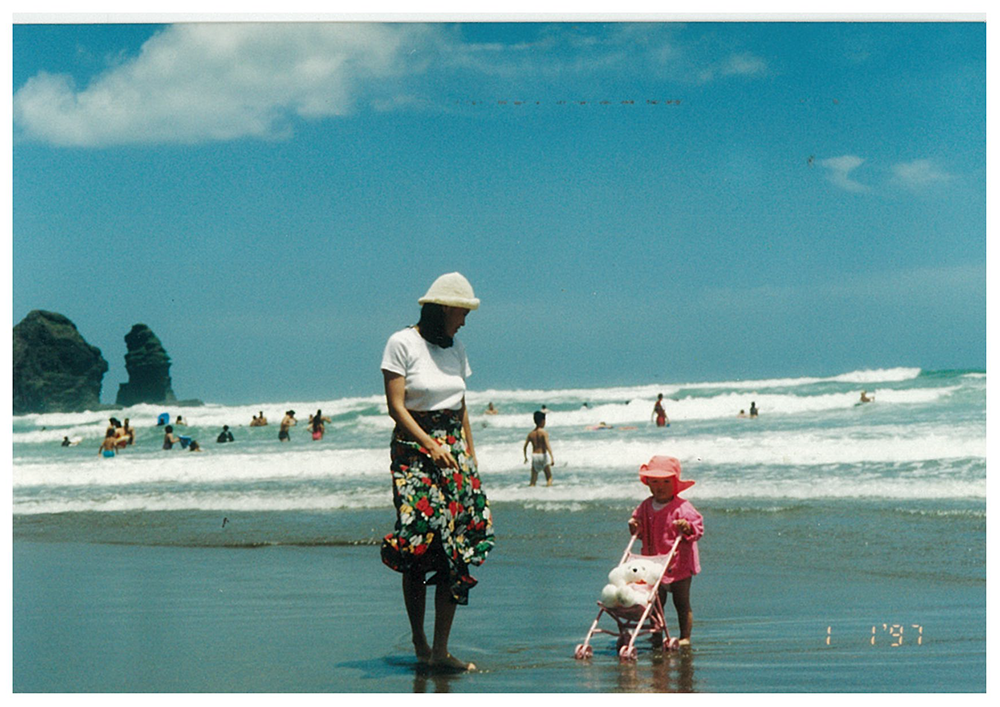
The writer and her mum in Tāmaki Makaurau, 1997.
Aram Wu, who’s currently working on an educational resource on allyship with Māori, also came to Aotearoa from Taiwan in the 90s. He describes it as a time where, “racial tensions towards East Asians fuelled by New Zealand First anti-immigration rhetoric was at all-time high.” At his school, he was told to only speak in English to better assimilate into the ‘Kiwi’ way. “I harboured a sense of shame and rejection towards my language, my culture and my heritage to achieve the ultimate goal, being a Kiwi,” says Aram. “Irony was, I then had to spend thousands of dollars in university fees to learn my own language taught by Pākehā lecturers for the beginning of my own reclamation.”
Once at university, Aram was able to learn more deeply about our history beyond the cursory glances at the ‘The Treaty of Waitangi’ (as distinguished from Te Tiriti o Waitangi) offered in the standard school curriculum.
“Then the deep realisation set in: New Zealand has a problem. It has a racist problem not only towards immigrants but the inherent racism that is deeply rooted in the colonial legacy of this country towards Māori. What we suffered is still a small fraction compared to the land stolen, the suppression of one’s identity, culture, language, being and existence.”
“I often hear the words 不关我的事 (bù guān wǒ de shì), not my problem, this is not my issue,” says Aram of the attitudes he sees in his Taiwanese communities. “As immigrants, we have to make this our problem.”
One mind shift to both help us find our grounding as Asian migrants in this country and recognise that, really, this is our problem, is through recognising Te Tiriti. Instead of relegating ourselves to the role of ‘gate-crasher’ (or altogether disinterested side party), how about ‘Treaty partner’?
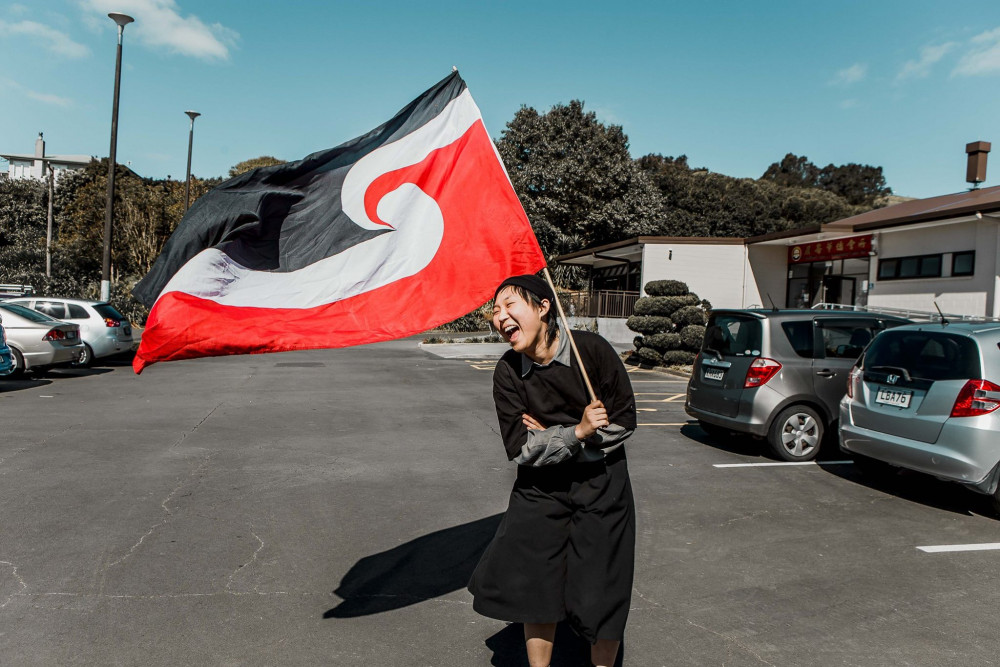
Asians Supporting Tino Rangatiratanga member Qian-Ye and the Tino Rangatiratanga flag. Photo: Julie Zhu
“Something that I used to struggle with as tauiwi, as an Asian who's not Māori or Pākehā, was: who am I to be getting involved in these issues?” says Janne Song, a Korean New Zealander working in the public sector in her first job out of university. A formative moment came when a university lecturer framed everyone’s status in Aotearoa as tangata tiriti.
“[They] helped me realise that Te Tiriti is what allows us to be here, and the minute you step foot in New Zealand, you become a partner to that treaty. For me, that was really important to be like, okay, so there is a mandate for me to do this. We shouldn't be saying, ‘Oh, this isn't our problem. I'm not Pākehā, so I'm not going to get involved’. Actually, you do have a duty.”
Mahdis Azarmandi, a lecturer at the University of Canterbury whose research has focused on racism and colonisation, reiterates this point saying, “Our existence here does infringe on Māori sovereignty, whether we like it or not. So as tangata tiriti we have an obligation to acknowledge that sovereignty and to uphold the Treaty.”
How can Asian New Zealanders find solidarity with Māori?
From the late 19th century, Māori and earlier Chinese migrants shared a kind of solidarity together, “because both were on the fringe of society,” says Manying.
“Socially, for example, they lived side by side, because they're market gardeners. There were romances and intermarriages and the rise of Māori-Chinese families. They were both in the same socioeconomic class. And both were politically deprived; the Chinese couldn't vote until they became citizens, which was in the 1950s. We can say that the Chinese and Māori were cousins in adversity, because both were equally despised.”
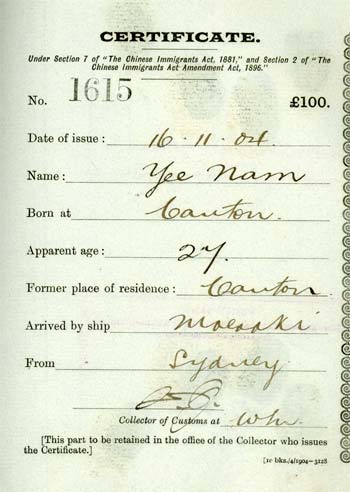
A poll tax certificate receipt from November 1904. From 1881, a poll tax was imposed on only Chinese immigrants to Aotearoa via the Chinese Immigrants Act, 1881. (Source: Archives New Zealand - Te Rua Mahara o te Kāwanatanga) (CC 3.0)
I passed Manying’s words on to my mum, and this notion that Chinese and Māori were once “cousins in adversity” came to her as a pleasant surprise. She admits that the last time she had any meaningful interaction with Māori people was with our neighbour George in Mt Albert over a decade ago (we still use the bookshelf George gifted us). The fact that Māori and Chinese people were once so close, that this was the norm rather than the exception, feels like a kind of hidden golden nugget of history.
And it lays some groundwork to build from for present-day solidarity between Asians and Māori.
One place to start growing those tendrils of connection in the present could be by looking to our whakapapa.
The question, “Where are you from?” has evolved into a loaded emblem of racial microaggression against Asian diaspora worldwide. It’s a question that, in some contexts, serves to accentuate you as foreign, as an Other. Meanwhile, those of white European origin who have no more claim to the land as you do are just regular ol’ New Zealanders with no need to hyphenate with, say, “Indian-” or “Filipino-”. Some white New Zealanders to this day still bristle at the term ‘Pākehā’ as it defines them as an ethnic group like any other ethnic group in New Zealand, rather than take them for granted as the default, quintessential New Zealander.
But in the context of tikanga Māori, this question can become the basis of forming connections between Māori and Asians and, really, among Asians ourselves.
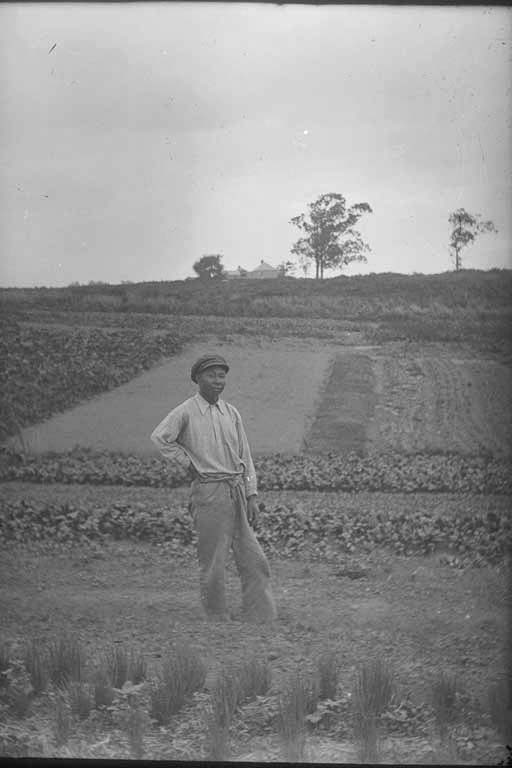
A Chinese market garden on Great North Road in the 1900s (Source: Auckland Libraries Heritage Collections)
Tayyaba Khan came to New Zealand in the 90s (like many of us), from Pakistan by way of Japan. She is the founder of the Khadija Leadership Network and has involved herself in activism for many years, especially following 9/11 and the Islamophobia that raged even more fervently after that day.
Tayyaba says we can focus on emphasising the commonalities among the places we come from and their histories. People from her Pakistani community might better empathise with how colonisation continues to impact Māori people today when viewed through the lens of British colonisation of India, and the carnage of the 1947 partition of British India into India and Pakistan, which has led to conflict that continues today. Tayyaba says by making those connections and talking about “what that meant in terms of how we see whiteness today is less likely to get me into an awkward position with my community.”
Mahdis agrees, saying, “The solidarity that emerges out of shared experiences of colonisation, even if they're distinct, is really helpful. Drawing those parallels really helps because I think it hits home, particularly for the generation of parents and grandparents who have vivid recollection of living under colonial administration.”
Mahdis also suggests we can “share the burden” of speaking up. “We all know how hard it is when we have to educate white people when they say something or do something racist.” Asians have experienced that through Islamophobia, for example, or through the rise of anti-Chinese sentiment with Covid-19 fears.
“We're exhausted, having to educate. So I love when a friend just steps in and just says something. I'm like, thank you very much. I'm tired. And we have an obligation to do that for Māori too… I think there's strength in sharing our pain, because it makes it less heavy for us to bear.”
Mahdis and Tayyaba, along with several of the other voices we’ve heard from, have been working on sharing that pain and labour through Asians Supporting Tino Rangatiratanga (ASTR), a group for people with pan-Asian whakapapa supporting Māori sovereignty. Through events, workshops and, really, day-to-day life, they engage their communities in conversations about the impact of colonisation and white supremacy in Aotearoa.
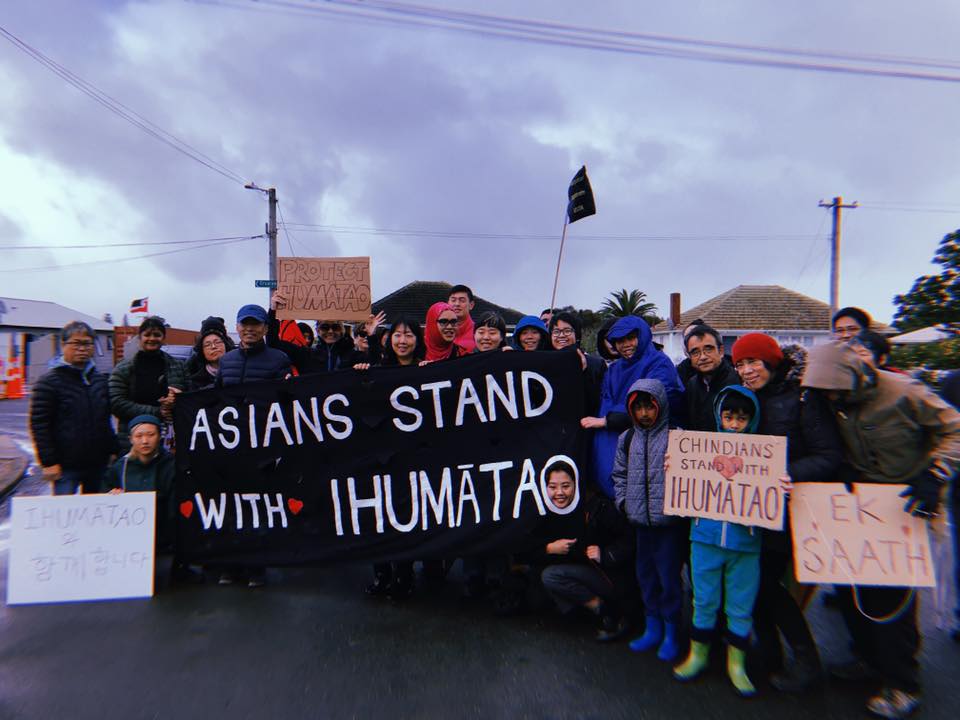
ASTR at Ihumātao, 2019. Photo provided by ASTR.
With the recent peak in public consciousness of the Black Lives Matter movement, there has been a flurry of resources and articles on how Asian Americans can be effective allies for African Americans (as well as a flurry of responses to the merits and weaknesses of those resources).
But an underlying theme seems to be that the onus is on those with the means to do so to educate themselves and help educate others. And through that education, we can dismantle the ways we both interpersonally and structurally contribute to racism in Aotearoa. This is the work ASTR has been doing for years.
Aram says this educational process involves both unlearning racist and one-sided narratives, as well as learning new knowledge. For him and several other members, a key learning was our obligation as tauiwi to Te Tiriti which codifies Māori sovereignty. Learning about Bastion Point was also helpful for Aram as an example grounded in recent history of the Crown forcefully taking Indigenous land. Other avenues to follow are learning the history and kaupapa of your local area, learning te reo, and learning your own heritage and history stemming back to Asia.
Self-reflection, Aram suggests, is another part of this process. What presence does colonialism and imperialism have in the histories of our home countries in Asia, and how does it bleed into the mindsets and trauma we’ve carried into our home country of Aotearoa? How does colourism in Asia, which was intensified by white European colonisation (a chapter in the histories of many Asian countries), trickle into our worldview today? Is it just a matter of rejecting skin-whitening creams, or is its impact much more insidious in how it affects how we view ourselves and others? In what ways do we hold economic and political power, gained from working within white structures on colonised land, that others in this country don’t?
What’s also notable about ASTR beyond their efforts to educate themselves and others, however, is how this organisation connects disparate groups of Asian New Zealanders together. While many tauiwi are disconnected from tangata whenua, there is also disconnection among pan-Asian tauiwi. It seems this would be an interpersonal matter, but Tayyaba suggests it is also a matter of policy.
She says government initiatives are only geared to “make sure communities are flourishing on their own, because the assumption is that you want to just engage and interact with your own ethnically specific community.”
“They're not going to do work where actually the Chinese community is engaging with a Pakistani community… There is no interest from the government around putting initiatives in place where Māori engage with tauiwi. Where are those initiatives? Do you see them? If we just made that shift alone, it would change the game in this country.”
Considering critical mass is crucial to a successful movement, it really would change the game. If one tenet of effective activism in Aotearoa is education, forming connections among Asian tauiwi, and between Asians and tangata whenua, is another.
Race Relations Commissioner Meng Foon was notable during his time as mayor of Gisborne (from 2001-2019) as being the only mayor in the country who was fluent in te reo Māori. He’s a high profile example of an Asian New Zealander who has meaningfully engaged with te ao Māori and Māori people.
“I think it's imperative that we all learn about the [Indigenous] people of this country and make friends with them,” he says. “Because together we can work together and trade together and enjoy each other's company and enjoy the food and marry each other.”
At the end of our conversation, Meng leaves me with these words:
“Make an effort. It’s as simple as saying, I want to learn more.”
For Asian New Zealanders who want to learn more, a useful place to start is this resource list created by Migrant Zine Collective and Asians Supporting Tino Rangatiratanga.
Thank you to members of Asians Supporting Tino Rangatiratanga for their feedback and guidance for this article.
Banner photo: Julie Zhu